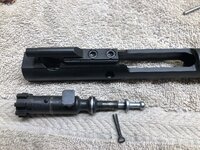Bronze Supporter
- Messages
- 5,466
- Reactions
- 13,723
The official Army and Air Force maintenance manuals both direct the user to ensure the gaps in the three gas rings are not lined up. Whether it would actually make a difference I don't know.
Follow along with the video below to see how to install our site as a web app on your home screen.
Note: This feature may not be available in some browsers.
The official Army and Air Force maintenance manuals both direct the user to ensure the gaps in the three gas rings are not lined up. Whether it would actually make a difference I don't know.
Pretty nil, what BCG did you change to?
Fail Zero BCGPretty nil, what BCG did you change to?
Yes they did! I'm working on putting the adjustable gas block on nowI think I was in @OregonArmsAmmo while you were @Yvette ... sounds like they got you taken care of with a higher power scope and adjustable gas block.
@3MTA3 this reminds me.
I really only have an issue with the gas after a few mag dumps, and I believe it is the oil boiling off.
ot
I'm just going to throw this out there... I've taken it apart and cleaned it. I've changed the bolt carrier group and I've changed the charging handle. What is the possibility that I did not put something back together correctly? Several of you guys say you have no issues with this.
Fail Zero BCG
Convert to a piston system.
SIONICS is supplying the weapon pre-suppressed? If that is the case then they most likely dialed in the gas port hole for a suppressed rifle...correct?I know a lot of people recommend and use an adjustable gas block, I have no use for them. They introduce additional and unnecessary complexity to the gas system, which, other the mags and ammo (neither of those have anything to with the gun), is the number one issue facing AR's. If the barrel was properly ported in the first place there would be no need. Once again, they are another bandaid approach. There is an entire industry that exists thanks to sub-par AR components.
I can tell you with 100% certainty SIONICS supplies dozens of LE departments with suppressed weapons without adjustable gas blocks. I was in an armorers class last month, the instructor (Will Larson, God rest his soul) stated the same thing. He was their master armorer.
No way.
The truth is a standard AR design is a piston system, the carrier is the cylinder and bolt it the piston (with rings on the tail). The in-line gas system is part if the AR's genius. If you want a traditional piston system get an AK.
Grab buffer tube end, shake the other end towards the ground. Cam moves forward along with bolt and perfect alignment to put back into upper.I can't remember how this goes back on the install is it ONE OR TWO
ONE
View attachment 603286
TWO
View attachment 603292

I fail to see any difference in photos but neither one will work as you must pull bolt out all the way to re-assembleI can't remember how this goes back on the install is it ONE OR TWO
ONE
View attachment 603286
TWO
View attachment 603292